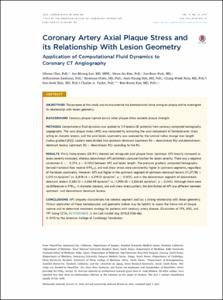KUMEL Repository
1. Journal Papers (연구논문)
1. School of Medicine (의과대학)
Dept. of Internal Medicine (내과학)
Coronary Artery Axial Plaque Stress and its Relationship With Lesion Geometry: Application of Computational Fluid Dynamics to Coronary CT Angiography
- Keimyung Author(s)
- Nam, Chang Wook
- Department
- Dept. of Internal Medicine (내과학)
- Journal Title
- JACC Cardiovascular Imaging
- Issued Date
- 2015
- Volume
- 8
- Issue
- 10
- Keyword
- Axial plaque stress; Computational fluid dynamics; Coronary artery disease; Coronary computed tomography angiography; Coronary plaque; Pressure; Wall shear stress
- Abstract
- OBJECTIVES The purpose of this study was to characterize the hemodynamic force acting on plaque and to investigate
its relationship with lesion geometry.
BACKGROUND Coronary plaque rupture occurs when plaque stress exceeds plaque strength.
METHODS Computational fluid dynamics was applied to 114 lesions (81 patients) from coronary computed tomography
angiography. The axial plaque stress (APS) was computed by extracting the axial component of hemodynamic stress
acting on stenotic lesions, and the axial lesion asymmetry was assessed by the luminal radius change over length
(radius gradient [RG]). Lesions were divided into upstream-dominant (upstream RG > downstream RG) and downstreamdominant
lesions (upstream RG < downstream RG) according to the RG.
RESULTS Thirty-three lesions (28.9%) showed net retrograde axial plaque force. Upstream APS linearly increased as
lesion severity increased, whereas downstream APS exhibited a concave function for lesion severity. There was a negative
correlation (r ¼ 0.274, p ¼ 0.003) between APS and lesion length. The pressure gradient, computed tomography–
derived fractional flow reserve (FFRCT), and wall shear stress were consistently higher in upstream segments, regardless
of the lesion asymmetry. However, APS was higher in the upstream segment of upstream-dominant lesions (11,371.96
5,575.14 dyne/cm2 vs. 6,878.14 4,319.51 dyne/cm2, p < 0.001), and in the downstream segment of downstreamdominant
lesions (7,681.12 4,556.99 dyne/cm2 vs. 11,990.55 5,556.64 dyne/cm2, p < 0.001). Although there were
no differences in FFRCT,%diameter stenosis, and wall shear stress pattern, the distribution of APS was different between
upstream- and downstream-dominant lesions.
CONCLUSIONS APS uniquely characterizes the stenotic segment and has a strong relationship with lesion geometry.
Clinical application of these hemodynamic and geometric indices may be helpful to assess the future risk of plaque
rupture and to determine treatment strategy for patients with coronary artery disease.
- Keimyung Author(s)(Kor)
- 남창욱
- Publisher
- School of Medicine
- Citation
- Joon-Hyung Doh et al. (2015). Coronary Artery Axial Plaque Stress and its Relationship With Lesion Geometry: Application of Computational Fluid Dynamics to Coronary CT Angiography. JACC Cardiovascular Imaging, 8(10), 1156–1166. doi: 10.1016/j.jcmg.2015.04.024
- Type
- Article
- ISSN
- 1936-878X
- Appears in Collections:
- 1. School of Medicine (의과대학) > Dept. of Internal Medicine (내과학)
- 파일 목록
-
-
Download
 oak-2015-0069.pdf
기타 데이터 / 1.04 MB / Adobe PDF
oak-2015-0069.pdf
기타 데이터 / 1.04 MB / Adobe PDF
-
Items in Repository are protected by copyright, with all rights reserved, unless otherwise indicated.